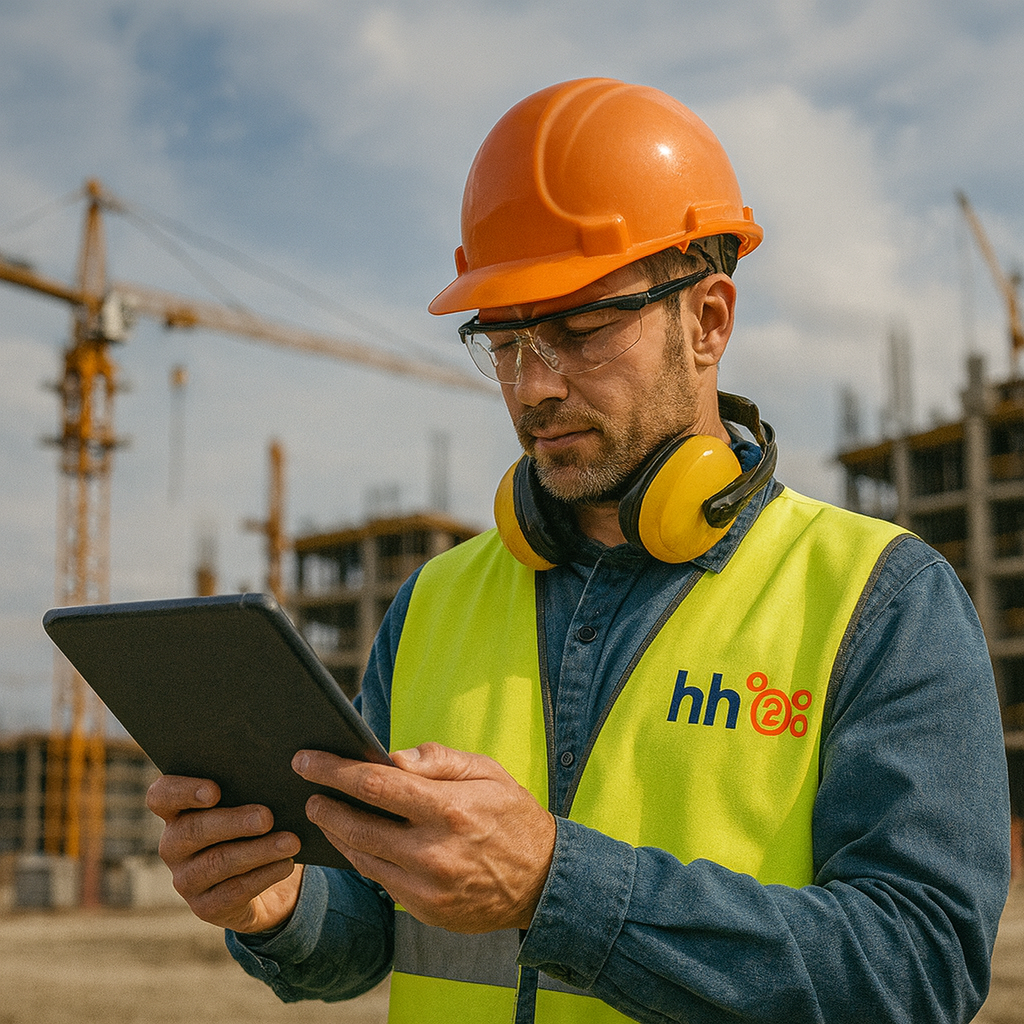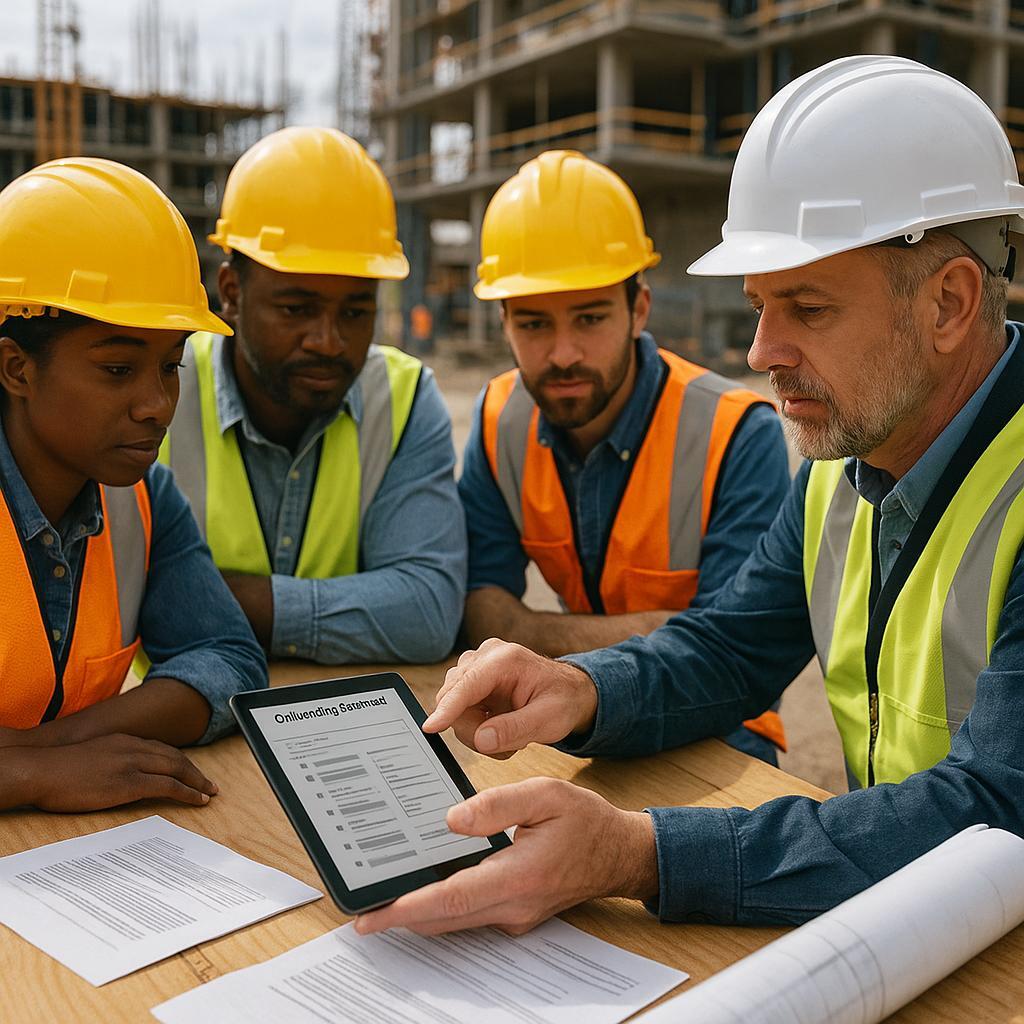The Real Cost of Construction Employee...
![]()
Your best carpenter just gave two weeks' notice. Again.
Explore essential strategies for effective construction employee management with our comprehensive guide.
1: Understanding Construction HR
4: Compliance and Legal Issues
8: Technology in Construction HR
9: Future Trends in Construction HR
Welcome to hh2's "Ultimate Guide to Construction Human Resources" - your comprehensive resource dedicated to the unique challenges and opportunities HR professionals face in the construction industry. Aiming to empower HR teams with the knowledge and tools necessary to excel in their roles.
This guide ensures that construction projects and companies operate efficiently, safely, and in compliance with relevant laws and regulations.
Distinct from other sectors due to its project-based nature, physicality of work, and substantial economic impact, the construction industry is truly unique.
Typically complex, projects require coordination of various skilled trades and management levels, all under tight deadlines and budgets. Adding to the complexity, construction work is highly variable - influenced by economic cycles, geographic and environmental factors, and regulatory changes.
A defining characteristic of the construction industry? Its reliance on a mobile workforce. Workers often travel from project to project, working under varying conditions. And this transient nature of employment, it presents unique challenges for HR professionals in areas such as recruitment, workforce stability, and training continuity.
Human resources in construction - it's not just about hiring and firing. No, HR plays a critical strategic role, impacting all facets of operations. Here's how HR serves as the backbone of successful construction operations:
Designed to provide you with a deep understanding of HR's integral role in the construction industry, this guide covers effective strategies for managing recruitment, hiring, training, and compliance. But that's not all - we also offer insights into workforce management, safety protocols, employee relations, and the use of technology in HR practices.
By the end of this guide, you'll have a robust toolkit that enables you to:
Whether you're new to HR in construction or looking to refine your existing skills, consider this guide your essential resource. It's here to help you overcome the industry's challenges and achieve success in your HR initiatives.
In this chapter, we delve into the foundational elements of Human Resources within the construction industry. HR in construction - it's not just about managing workforce dynamics. No, it plays a pivotal role in steering the company through complex regulatory landscapes and fluctuating market conditions. Here, we explore the specific roles and responsibilities of HR professionals in construction. And we address the unique challenges they face.
Human Resources in construction involves a multifaceted set of responsibilities, extending beyond traditional HR functions. The following are key roles specific to HR in the construction industry:
Recruitment and Staffing: In this project-based industry, HR must efficiently manage the flow of workers, ensuring that projects are adequately staffed with skilled workers at the right times. This includes forecasting labor needs, sourcing candidates, conducting interviews, and executing hiring processes. It's no small feat!
Training and Development: Given the high risks associated with construction work, continuous training is crucial. And HR? They're responsible for organizing orientation sessions for new hires, ongoing training programs for skill enhancement, and safety training. All of which are mandatory to meet industry standards and regulations.
Safety Compliance: HR must ensure all operations comply with national and local safety laws. Why? To protect workers and avoid legal issues. This includes keeping up to date with OSHA regulations, facilitating safety audits, and maintaining records of safety training and incidents. It's a crucial role.
Labor Relations: In many regions, construction workers are unionized. HR must manage relationships with unions, negotiate labor contracts, resolve disputes, and ensure that the terms of labor agreements are met. It's a delicate balance.
Employee Relations: HR also manages the overall workplace environment. This includes resolving conflicts, handling employee grievances, and creating policies that foster a positive and productive work culture. Happy workers, better results.
Performance Management: Constructing accurate job descriptions, setting clear performance standards, and evaluating employee performance regularly - these help ensure that project goals are met and that workers are performing to their best abilities.
Compensation and Benefits: Designing competitive compensation packages is crucial in attracting and retaining talent, especially skilled labor, which is in high demand in many markets. HR must stay on top of industry trends to remain competitive.
The dynamic nature of the construction industry presents several challenges for HR professionals:
Seasonal Nature of Work: Construction activity often fluctuates with the seasons, impacting labor demand. HR must plan for these fluctuations, developing strategies for scaling the workforce up or down efficiently. It's a constant juggling act.
High Turnover Rates: The industry often experiences high turnover, driven by project completion, seasonal work, and the physically demanding nature of the jobs. HR must develop strategies to retain workers, such as competitive compensation, career development opportunities, and robust safety programs. Keeping the best talent is key.
Safety Concerns: Construction - it's one of the most hazardous industries, with high risks of accidents and injuries. Maintaining a strong safety culture and compliance is a continuous challenge that HR must address through training, monitoring, and enforcing safety protocols. Safety first, always.
Regulatory Compliance: Staying compliant with labor laws, safety standards, and building regulations requires HR to be vigilant and proactive. Missteps can lead to legal liabilities, fines, or work stoppages. HR must stay on top of the ever-changing regulations.
Workforce Diversity: Managing a diverse workforce in terms of skills, backgrounds, and the varying legal status of workers (especially in regions with high rates of immigration) requires sophisticated management skills and robust HR policies. Diversity is a strength, but it also presents unique challenges.
Technology Integration: Adapting to new technologies for HR management, such as digital record-keeping, workforce analytics, and automated recruitment systems, while maintaining data security and compliance. HR must embrace technology to stay efficient and competitive.
Remote Workforce Management: Managing a workforce that is spread across multiple sites and possibly regions - it poses communication and supervision challenges. HR must find innovative ways to keep everyone connected and on the same page.
These roles and challenges define the contours of what it takes to manage human resources in the construction industry effectively. As we move forward in this guide, we will delve deeper into each of these areas.
We'll provide strategies and solutions to help HR professionals meet these challenges head-on and drive their organizations to success. It's a tall order, but with the right tools and mindset, it's achievable.
In the construction industry, effective recruitment and hiring are essential. Why? To ensure projects are delivered on time, within budget, and to the required quality standards. This chapter outlines the strategic approach to recruitment and hiring. We'll detail best practices for developing robust recruitment strategies, crafting effective job postings, and executing thorough interviewing and selection processes. Let's dive in!
A well-thought-out recruitment strategy - it's vital for sourcing and retaining top talent in construction. Here are some best practices:
Understand the Labor Market: Analyze the current labor market trends. Understand the availability of skilled workers, typical compensation packages, and primary factors influencing employment choices in construction. It's your roadmap.
Define Role Requirements: Clearly define what skills, experiences, and qualifications are required for each role. This helps in targeting the right candidates. And it reduces time spent on unsuitable applicants. Precision is key.
Establish Clear Recruitment Goals: Set clear, measurable recruitment objectives, such as time-to-hire, cost-per-hire, and diversity targets. Why? To streamline the recruitment process. Goals keep you on track.
Engage with Trade Schools and Apprenticeship Programs: Build relationships with educational institutions and apprenticeship programs. Tap into a pool of motivated workers with foundational skills. Nurture the future talent.
Utilize Multiple Sourcing Channels: Expand your reach. Use a combination of traditional job boards, online construction-specific recruitment platforms, social media, and participation in industry networking events.
Implement Employee Referral Programs: Encourage current employees to refer skilled professionals from their networks. Consider offering incentives for successful hires.
Focus on Employer Branding: Develop a strong employer brand that highlights your company's culture, projects, and commitment to employee development and safety. This attracts not just job seekers, but the right kind of talent that aligns with your company's values. Brand matters.
Creating compelling job postings is crucial. You want to attract quality candidates:
Clear Job Titles: Use clear and precise job titles that accurately reflect the role and responsibilities. Avoid internal jargon that may confuse job seekers. Clarity is king.
Detailed Job Descriptions: Include detailed job responsibilities, required qualifications, and desired skills. Clearly outline what the day-to-day activities will look like. And specify any tools or technologies the candidate will use.
Highlight Safety and Training: Emphasize your company's commitment to safety and ongoing training. These are significant considerations for construction workers. Show you care.
Promote Your Company Culture: Describe your company culture and what makes it unique. Mention any benefits, such as healthcare, retirement plans, or family leave policies, that could attract candidates.
Call to Action: End the job posting with a strong call to action. Tell candidates exactly how to apply and what the next steps will be. Make it easy.
SEO Optimization: Optimize job postings for search engines. Use relevant keywords that potential candidates might use to find job opportunities.
The interviewing and selection process is critical. You want to ensure that the most suitable candidates are hired:
Structured Interviews: Use structured interviews with a standard set of questions. This ensures consistency and fairness in how candidates are evaluated. Level the playing field.
Behavioral Questions: Incorporate behavioral questions that require candidates to describe past work experiences, outcomes, and the strategies they employed in different scenarios. This can provide insight into their problem-solving and interpersonal skills. Actions speak louder than words.
Skill Assessments: Depending on the role, consider practical skill assessments or trials. Evaluate the candidate's capabilities directly relevant to construction tasks. See them in action.
Cultural Fit: Assess whether the candidate's values align with the company culture. This is particularly important in construction, where teamwork and safety are paramount. Fit is crucial.
Reference Checks: Always conduct reference checks. Validate the information provided by the candidate. Gain insights into their work ethic and past performance. Trust, but verify.
Regulatory Compliance: Ensure all hiring practices comply with employment laws, such as non-discrimination policies and right-to-work checks. Stay legal.
Effective employee onboarding is crucial in the construction industry. It sets the stage for new hires to become productive, engaged, and safe on the job. A well-structured onboarding process not only integrates employees into their new roles but also instills a sense of belonging and commitment to the company's objectives.
This chapter covers the essential elements of onboarding, training, and mentorship within the construction environment. Let's get started!
The onboarding process in construction should be comprehensive. It should encompass not just the first day on the job but extend over several weeks or months. Here's a step-by-step guide to integrating new hires:
Pre-Onboarding Communications: Before the employee's start date, send them information about the company, their role, the project they will be working on, and what they can expect on their first day. This might include safety protocols, gear they'll need, and whom to report to upon arrival. Set them up for success from day one.
First Day Orientation: Welcome new hires with a thorough orientation session. Introduce them to their team and key personnel in the organization. Cover administrative essentials, such as badge issuance, paperwork, and IT setup. Make them feel at home.
Safety Training: Given the high-risk nature of construction, immediate and comprehensive safety training is mandatory. This should cover all relevant safety protocols, emergency procedures, and the correct use of safety equipment and machinery. Safety first, always.
Project-Specific Training: Introduce new hires to the specific details of the project they will work on, including goals, timelines, key contacts, and their role in the project's ecosystem. Context is key.
HR Policies and Procedures: Educate new employees about HR policies, including working hours, leave policies, reporting structures, and where to go for help. Clarity from the start prevents confusion later.
Continuous Check-Ins: Schedule regular check-ins. Provide feedback, address concerns, and help new hires adjust to their roles. These could be daily initially, then weekly, and eventually moving to monthly. Consistent communication is crucial.
Developing effective training programs is critical. Why? To ensure that employees have the necessary skills and knowledge to perform their tasks safely and efficiently:
Skills Development: Identify the skill gaps among employees. Develop training programs aimed at these areas. This could include technical skills for specific machinery, software training for project management tools, or soft skills like communication and teamwork. Upskilling is a continuous process.
Regular Updates: Construction techniques and technologies evolve rapidly. Regular training sessions should be conducted to keep staff updated on new practices and innovations. Stay ahead of the curve.
Safety First: Continually emphasize safety training. Regular refreshers are necessary to keep safety practices top of mind and to introduce new regulations or equipment. You can never be too safe.
Certifications: Provide opportunities for employees to gain or renew their professional certifications. This not only improves their skill set but also aids in compliance with industry standards. Invest in your people.
Mentorship - it's an invaluable part of the onboarding and ongoing development process in construction. Here's why and how to implement it:
Role of Mentorship: Mentors can provide new hires with insights and advice based on real-life experiences. They help them navigate the complexities of the construction site and company culture. Wisdom is meant to be shared.
Pairing New Hires with Experienced Employees: Match new employees with seasoned veterans who can guide them through the early stages of their construction careers. This relationship can help new hires understand work processes, safety protocols, and the nuances of working within their new environment. Experience is the best teacher.
Support Networks: Establish networks or groups that can offer support, share knowledge, and provide social connections within the company. This can include peer groups, regular team meetings, and social events. A connected team is a strong team.
Feedback Mechanism: Implement a system where both mentors and new hires can provide feedback on the mentorship experience. This helps HR to continually refine and improve the mentorship and support structures. Feedback is a gift.
In the construction industry, compliance with employment law and effective management of legal issues are crucial for maintaining operational integrity and avoiding costly penalties. This chapter provides a thorough exploration of the key legal requirements in construction, documentation best practices, and strategies for managing union relationships.
Navigating the complexities of employment law is essential for construction HR professionals to ensure both regulatory compliance and protection for the company. Here are some fundamental areas to focus on:
Maintaining accurate and comprehensive records is not only a legal requirement but also a best practice that can save considerable time and resources in the event of audits or disputes:
Unions play a significant role in many construction environments, and managing these relationships effectively is crucial for maintaining labor harmony and project timelines:
By thoroughly understanding and adhering to employment laws, maintaining meticulous records, and managing union relationships proactively, construction companies can mitigate risks and focus on the successful completion of projects.
Effective workforce management is crucial for maintaining productivity and efficiency in the construction industry. This chapter explores strategies for managing the unique challenges associated with project-based scheduling, seasonal fluctuations, and performance monitoring.
Project-based scheduling in construction is complex due to the variability in project demands, locations, and workforce availability. Effective scheduling ensures that the right personnel with the right skills are in the right place at the right time. Here’s how to handle these complexities:
The seasonal nature of construction work can lead to periods of high labor demand followed by slowdowns. Managing this ebb and flow effectively is crucial:
Effective performance management not only enhances productivity but also boosts employee morale and professional growth. Here’s how to implement a robust performance management system:
This approach not only improves operational efficiency but also enhances worker satisfaction and retention.
In the construction industry, where the risk of injury is significantly higher than in many other sectors, establishing a robust safety management system is not just a regulatory requirement but a moral imperative. This chapter discusses the critical aspects of creating a safety culture, developing effective safety training programs, and setting up efficient incident reporting and response procedures.
The foundation of minimizing risks in construction begins with fostering a culture where safety is a paramount concern for everyone from the top executives to the newest hires on the site.
Developing and implementing an effective safety training program is critical to ensure that all employees understand how to perform their jobs safely.
Establishing a systematic approach to incident reporting and response not only helps in handling incidents effectively but also in preventing future incidents.
Employee relations are critical to maintaining a harmonious, productive work environment, especially in the construction industry where teamwork is essential for project success. This chapter delves into building team cohesion, handling conflicts and grievances, and implementing effective employee retention strategies.
Fostering a positive work environment where all team members feel valued and understood is fundamental to building cohesion. Here are effective techniques to achieve this:
Conflict is inevitable in any workplace, and effective resolution is key to preventing disruption:
Retaining skilled workers is especially challenging in the construction industry due to its project-based nature and the physical demands of the job:
The rapid evolution of technology has transformed many aspects of the construction industry, including human resources. This chapter explores the integration of technology in HR functions, focusing on HR Information Systems (HRIS), leveraging technology for recruitment and training, and utilizing data-driven decision making to enhance HR strategies.
HRIS are powerful tools that streamline HR operations, automate manual processes, and provide strategic data insights. Here’s how HRIS can benefit construction HR:
Adopting modern technologies can significantly improve the efficiency and effectiveness of recruitment and training processes:
Using analytics in HR decision-making can transform subjective decisions into objective, data-driven strategies:
The construction industry is undergoing significant transformations due to technological advancements, changes in workforce demographics, and increasing emphasis on sustainability. This chapter explores emerging trends in construction HR, strategies for adapting to these changes, and the integration of eco-friendly practices into HR processes.
Several key trends are set to reshape the future landscape of HR in construction:
To stay ahead in a rapidly evolving industry, HR professionals in construction must adopt a flexible and forward-thinking approach:
Integrating sustainability into HR processes is not only about environmental responsibility but also about building a resilient and ethically strong organization:
In this guide, "The Ultimate Guide to Construction Human Resources," we have explored a comprehensive array of strategies, best practices, and innovative approaches to managing HR in the construction industry. As we conclude, let's recap the key themes and strategies discussed throughout and provide resources for further exploration and learning.
To continue your journey in enhancing HR capabilities within the construction industry, consider the following resources:
This guide aims to serve as a foundation for building robust HR practices in the construction industry. By continuously learning, adapting to changes, and implementing the discussed strategies, HR professionals can significantly contribute to the success and sustainability of their organizations in this dynamic sector.
To support your understanding of the concepts discussed throughout "The Ultimate Guide to Construction Human Resources," this glossary provides definitions of key terms used in the guide. These definitions are intended to clarify terminology and ensure consistency in how terms are understood and applied.

Your best carpenter just gave two weeks' notice. Again.

Construction Safety Training in the Digital Age: How Technology Reduces Incidents and Saves Lives...

Building a diverse workforce isn't just the right thing to do, it's smart business. Here's how...

Construction payroll compliance has never been more complex—or more costly to get wrong. In 2024,...

The construction industry is experiencing an unprecedented digital revolution, and human resources...

As a self-performing general contractor, you've likely experienced the frustration of a key crew...
In construction, every minute counts, but many contractors are still losing hours each week to...

For many general contractors who self-perform, union payroll isn’t just another back-office...

Onboarding in construction rarely happens in an air-conditioned office. More often, it’s a...

If you’ve ever lost hours chasing down timesheets, fixing payroll mistakes, or waiting for the...
Subscribe to our email newsletter for the latest construction insights.